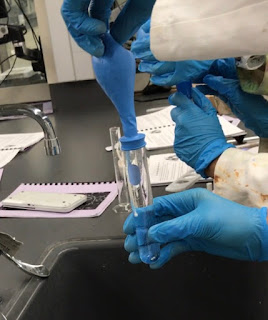Lab 10: Mole-Mass Relationships Lab
Mass-Mass Relationships Lab
Introduction:
The purpose of this lab was to attempt to get pure sodium chloride by combining sodium hydrogen carbonate and hydrochloric acid while practicing . This was done by first mixing the two together which would leave you with water and Sodium Chloride. Then, we evaporated the water using a hot plate leaving us with what should only be our sodium chloride. This number could be compared to the mathematical solution following the Law of Conservation of Mass and Mass to Mass Relationships.
(Picture of Resulting Sodium Chloride)
Conclusion/Questions:
Overall, this lab was pretty successful but in the end we still had a different yield from the theoretical yield which means we must have made a mistake somewhere in the process. The most likely point of error was probably not heating the evaporating dish with the sodium chloride long enough so there must have still been some extra water. This could possibly explain for the high yield.
1. Which reactant is limiting? How do you know?
The limiting reactant of this lab was the NaHCO3(Sodium Hydrogen Carbonate) because we only had a specific and limited amount of the substance and unlimited amount of the hydrochloric acid. This means that we won't have enough sodium hydrogen carbonate to match the hydrochloric acid which makes it the limiting reactant.
2. Find the theoretical yield of NaCl based on your limiting reactant. Show your work below.
2.02g NaCHO3 x 1mol NaCHO3 x 1mol NaCl x 58.44g NaCl = 1.41g NaCl
1 84.0077g NaCHO3 1mol NaCHO3 1mol NaCl
3. Find the mass for the remaining solid product after the evaporation of water based on your experimental data. (Show work.)
46.44g ⎼ 44.80g = 1.64g
↑ ↑ ↑
Mass of dish + remaining solid product Mass of dish Mass of remaining solid product
4. Find the percent yield for this experiment for the solid product. (Show work.)
Actual Yield = %Yield
Theoretical Yield
1.64g NaCl x 100 = 116%
1.41g NaCl




Comments
Post a Comment